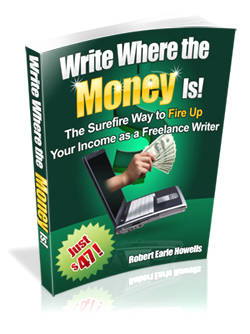
Write Where the Money is one well-rounded resource that can, and will explain pretty much any question you might have about any stage of writing for a magazine or a website. It was written by veteran writer/blogger Robert Earle Howells.
There are many amazing resources I’ve found about querying, contracts, formatting, writing and such, but I don’t think I have seen all of together, and written so well, in one place.
It’s a must for beginner writers, although it has a lot to teach and/or remind all levels of writers. And even if you’ve been writing and getting published successfully for years, it is still a handy resource to have because it does cover pretty much everything.
It’s a 154-paged PDF document, but it reads as fast as a page-turning work of fiction. Honestly. First time I was reading it, I almost forgot to get off at my bus stop.
But let’s give you more details on why you might need it too.
Below is a breakdown of basically what the book covers, though I interpreted chapter headings to give you a better idea. For the actual chapter names, take a look at the book’s sales page. (Yep, it’s an affiliate link. I stand by the book, and wish I had purchased it much sooner. It’s $47.)
I should mention that all chapters include quotes from other writers, editors and publishers, as well as experiences of Robert, and stuff he used for his own queries. And each chapter ends with a summarized action plan for you.
Here we go:
-How you know if you can write (or know about what to write)
-How to organize your ideas
-Why experience/clips don’t matter as much as good ideas
Now, technically, this is common sense. But it’s easy to get intimidated by our lack of experience in one area even if we have experience in others. So keep in mind that great ideas (and how well you present them) are what matters. And we were all beginners in a niche once.
Just keep brainstorming, and studying publications.
– How/where to get valid experience
He guides you on different strategies to get those first clips.
– What to pay attention to when choosing how to get your clips
– How to write something editors would want (aka how to write well)
– How to study and pitch a publication
– How to understand/interpret writer’s guidelines
There’re some very useful, but not-always mentioned tips on how to read a publication’s guidelines, what to believe and what (not) to take seriously, and what is said vs. what is meant.
– Tips on how to really write a successful query letter
Again, unless you’ve just started writing (congratulations, this is a resource that will get you very far without you having to collect all the information you need about writing, submitting and publishing from a hundred different resources), you are familiar most of the tips. But it’s practical to have a solid checklist.
– What comes after the query, deciphering contract terms, negotiating, rights
The book doesn’t leave you high and dry after sending the query letter. It features insights on how to follow-up, when to give up, how to react to similar ideas published in the same magazine that rejected yours and so on.
Then there’s the breakdown of not just rights, but other terms as well.
– Formatting/submitting
– Working with editors
This part informs you about how to react to edit and rewrite requests professionally; as well as developing long-lasting relationships that will land you assignments without querying (much).
– How much you earn, and how to know an article’s actual worth, what to do when the payment is late
Plenty of magazines do in fact pay a lot better than blogs. Even the publications that pay for both print and online content pay more for the print articles. However, they also happen to expect a lot more in terms of research, experts and interviews.
I’m not saying you shouldn’t do your best when you are writing for the web. You definitely should. However you will see that sometimes an article that pays 3 grand won’t have paid as much as the 50 bucks you got for that 500-word piece for a blog. He explains how.
This section also gives you ideas on how to re-slant your articles and what more you can do with them. Moreover, there’s detailed information service articles vs. feature pieces.
– Defining/finding markets
Different types of publications are explained, along with tips on what to expect from them. Job boards are analyzed. And there’s also information on how to monetize your own blog.
– Qualities you need to become successful: This is divided into two chapters.
And it’s not just about clear writing or being more productive (though they are obviously covered). It pretty much tells you what you need to manage your business, writing and life properly so that you will be a successful writer.
– Wisdom, tips and experiences of fellow writers
This part is great for gaining (and keeping) you faith and confidence.
– Glossary for the writing business terms
– Resource Listing: from markets to associations.
*
All in all, it is a book to keep as a resource as long as you are writing non-fiction. It should be kept where you can refer to as fast as you need, whenever you need it.
Click Here!